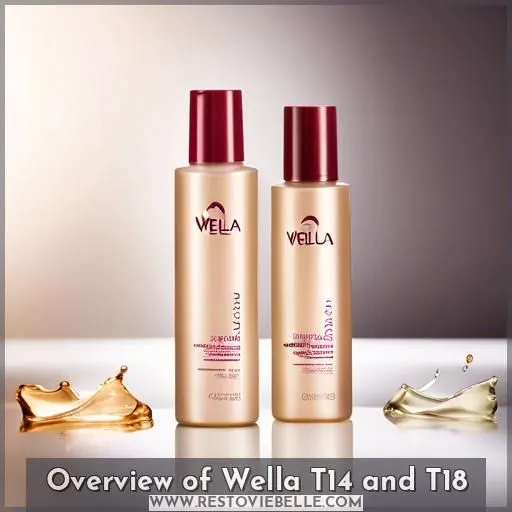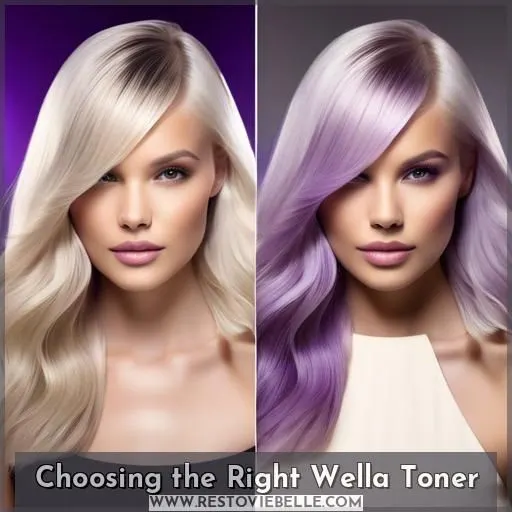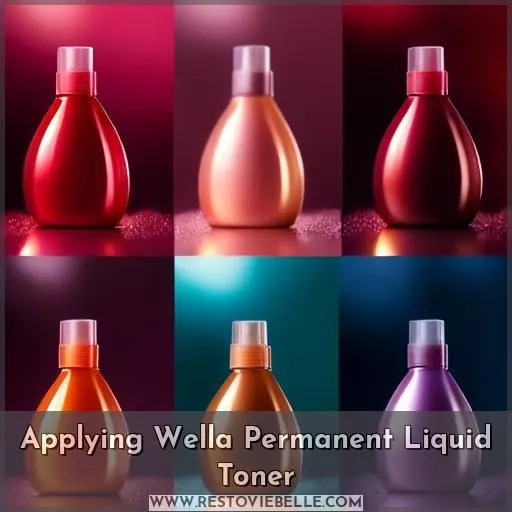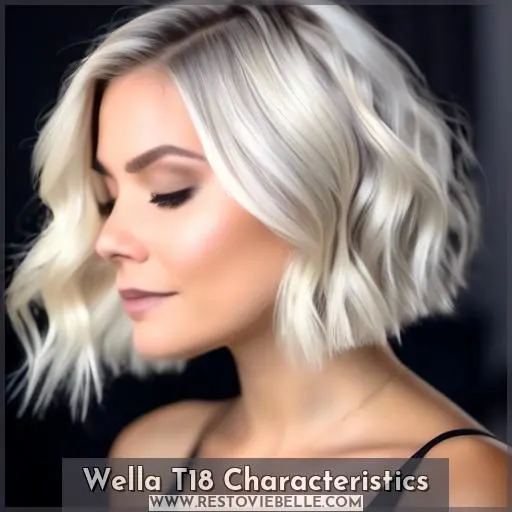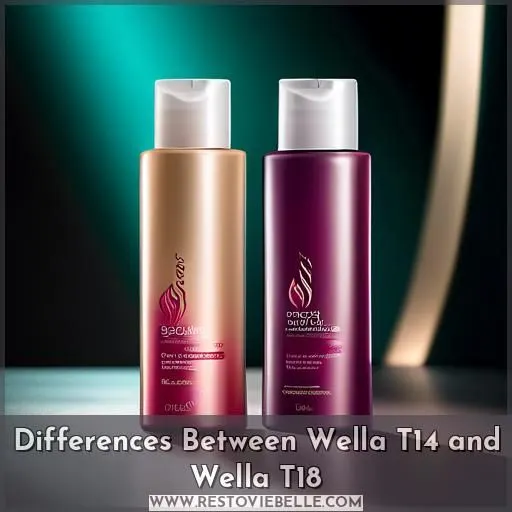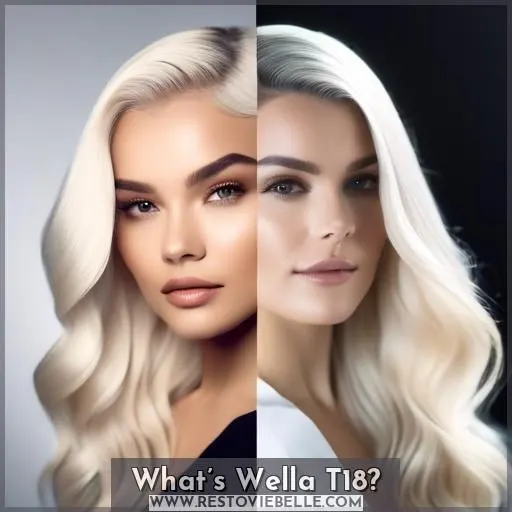This site is supported by our readers. We may earn a commission, at no cost to you, if you purchase through links.
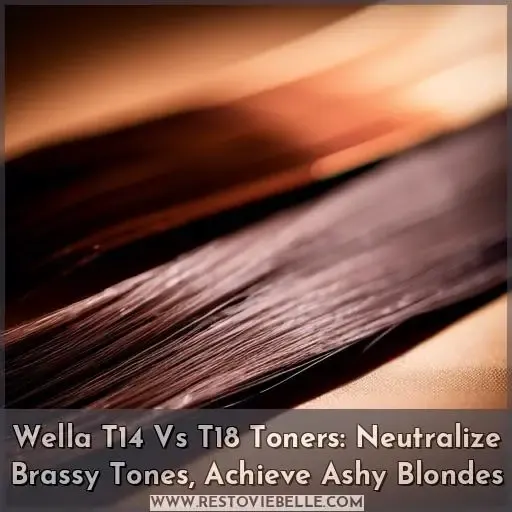 Wella T14 and T18 are permanent liquid toners ideal for neutralizing unwanted tones in blonde hair. T14’s violet-blue base counteracts orange/gold undertones, leaving a silvery ash blonde. Use it for hair levels 9+ with orange tones. T18’s violet base targets yellow tones, creating a light ash blonde for levels 10+.
Wella T14 and T18 are permanent liquid toners ideal for neutralizing unwanted tones in blonde hair. T14’s violet-blue base counteracts orange/gold undertones, leaving a silvery ash blonde. Use it for hair levels 9+ with orange tones. T18’s violet base targets yellow tones, creating a light ash blonde for levels 10+.
You’ll mix these toners with 10 or 20 volume developer for customizable results. Properly applying the right wella t14 vs t18 toner is key to achieving your desired ashy blonde hue. Learn more about their application process and unique benefits in the detailed guide below.
Table Of Contents
Key Takeaways
- Wella T14 and T18 are both ash toners, but they have different base colors that affect the outcome.
- Wella T14 has a blue base, which counteracts orange or gold tones in bleached hair, giving a pale ash blonde color with silvery gray tones.
- Wella T18 has a violet base, designed to neutralize yellow tones, leaving you with a light ash blonde color.
- Mixing T14 and T18 can create different shades of ash blonde, depending on the proportions of yellow to orange tones in your hair.
Overview of Wella T14 and T18
Let’s discuss Wella’s T14 and T18 toners. These ash toners are designed to neutralize warmth and achieve ashy blonde hair colors. T14 has a violet-blue base, making it ideal for neutralizing orange undertones, while T18 has a violet-violet base, making it better for neutralizing yellow undertones.
Ash Toners That Neutralize Warmth
Wella’s ash toners, T14 and T18, are designed to neutralize warmth in bleached hair. T14’s violet-blue base targets orange undertones, while T18’s violet-violet base tackles yellow tones, delivering cool, ash-blonde results.
These versatile toners help you achieve your desired shade, whether it’s a pale or light ash blonde.
- Wella T14: Violet-blue base, best for orange undertones
- Wella T18: Violet-violet base, best for yellow undertones
- Both toners mix with 10 or 20 volume developer for customizable results
T14: Violet-blue Base, Best for Orange Undertones
Wella T14 is a toner designed to neutralize orange undertones in hair.
It has a violet-blue base, making it suitable for level 9 blonde hair with orange undertones.
The blue base in T14 helps to counteract gold and yellow orange tones, leaving your hair with a cool ash-blonde color.
When mixed with a 10 or 20-volume developer, the toner can be applied to damp hair and left on for around 30 minutes.
To achieve the best results, it is recommended to mix T14 with a 20-volume developer for long-lasting results.
T18: Violet-violet Base, Best for Yellow Undertones
If you’re seeking to neutralize yellow undertones in your hair, Wella T18 is your go-to toner. With a violet-violet base, it’s specifically designed to counteract yellow tones, leaving your hair with a light ash blonde color.
- Violet-violet base: T18’s violet base is what makes it effective at neutralizing yellow undertones.
- Light ash blonde: The result of using T18 is a light ash blonde color, which is perfect for those looking to enhance their blonde hue.
- Neutralizing yellow tones: T18 is designed to counteract yellow undertones, making it an ideal choice for those with yellow-toned hair.
- Easy to use: T18 is a permanent liquid toner that mixes with 10 or 20 volume developer, making it easy to apply and process at home.
To get the best results from T18, follow these steps:
- Pre-lighten your hair: Before applying T18, ensure your hair is pre-lightened to the desired level.
- Mix with developer: Mix 1 part T18 with 2 parts 10 or 20 volume developer.
- Apply to towel-dried hair: Apply the mixture to towel-dried hair, ensuring it’s evenly distributed.
- Develop for up to 30 minutes: Develop the toner for up to 30 minutes, checking frequently to ensure you achieve the desired results.
Incorrect Toner Application May Not Affect Color
Incorrect toner application may not affect color immediately, but it can lead to ineffective toning, color mismatching, and even a waste of resources.
When using Wella T14 or T18 toners, consider your hair’s level and undertones, as well as the color wheel’s principles: purple cancels yellow, and blue cancels orange.
You may need to seek professional help if the toner doesn’t remove orange or red tones as expected.
Hair can be re-colored to its original shade after lightening, and bleaching is usually necessary for blonde hair.
Color-enhancing shampoos can also be used to add golden tones or balance brassy tones.
Choosing the Right Wella Toner
Consider your hair’s level and undertones to select the right Wella toner. Use a color wheel to determine which toner will best neutralize the unwanted warmth, remembering that purple cancels yellow and blue cancels orange.
Consider Hair Level and Undertones
When it comes to choosing the right Wella toner for your hair, it’s essential to consider your hair level and undertones. Wella T14 and T18 are both designed to neutralize brassy tones, but they target different undertones. T14 has a violet-blue base and is best for neutralizing orange undertones, while T18 has a violet-violet base and is best for neutralizing yellow undertones.
To determine your hair level, you can use a hair color chart or consult with a professional stylist. Hair color levels range from 1 to 10, with 1 being the darkest and 10 being the lightest. Tones represent the warmth or coolness of the shade and are indicated by letters, such as ‘G’ for golden or ‘A’ for ash.
When considering the combination of hair level and undertones, it’s important to remember that T14 is designed for hair that’s level 9 or higher and has orange undertones, while T18 is best for hair that’s level 10 or above and has yellow undertones.
To achieve the best results with Wella T14 or T18, it’s recommended to use a 10 or 20-volume developer and apply the toner to damp hair. The results can be seen in around 30 minutes, and the toner is designed to be highly pigmented and exceptionally fade resistant.
Use Color Wheel to Determine Color Cancellation
To achieve the perfect ash blonde hue for your hair, it’s crucial to understand color theory and undertone identification.
- Identify your undertones: Look at your skin and hair. If you have warm undertones, you’ll likely have golden, yellow, or olive undertones in your hair. If you have cool undertones, you’ll have ashy, silver, or platinum undertones.
- Determine the color cancellation: Use a color wheel to find the color that cancels out the unwanted undertones in your hair. For example, if you have orange undertones, you’d use a blue-based toner like Wella T14. If you have yellow undertones, you’d use a purple-based toner like Wella T18.
- Mix toners carefully: If your hair has both orange and yellow undertones, you can mix Wella T14 and T18 to neutralize both. Adjust the developer-to-toner ratios carefully and consider the proportion of yellow to orange tones in your hair.
- Apply mixed toners: Apply the mixed toner to specific areas or all over your hair, depending on the desired result. Different shades of ash blonde may result from the mixture.
Purple Cancels Yellow, Blue Cancels Orange
When it comes to neutralizing brassy tones in your hair, understanding color theory and color mixing is essential. Purple shampoo and blue dye, both containing violet pigments, play a crucial role in canceling out yellow and orange tones, respectively. Wella T14 and T18 toners are designed to work with this principle, using a violet base for T18 and a blue base for T14.
Wella T14 is best for neutralizing orange undertones, leaving your hair with a cool ash-blonde color. It’s a permanent liquid toner that mixes with 10 or 20-volume developer and processes for 30 minutes. T14 has a silvery grey tones result, making it ideal for those with orange or gold tones they want to remove.
On the other hand, Wella T18 is designed for yellow tones, giving your hair a light ash-blonde color with no violet undertones. It also mixes with 10 or 20-volume developer and processes for 30 minutes. T18 is perfect for those with yellow undertones they want to neutralize.
When choosing between Wella T14 and T18, consider the color wheel. Purple cancels yellow, and blue cancels orange. If your hair has more orange tones, choose T14, and if it has more yellow tones, choose T18.
To apply the toner, follow these steps:
- Strand and patch test for allergies.
- Separate your hair into thin sections.
- Mix 2 parts 20-volume developer with 1 part toner.
- Apply starting at the back, saturating sections.
- Process for 8-10 minutes for light toning, 20-25 minutes for darker toning.
Remember to use purple shampoo to prevent brassiness and lighten and tone gradually. Always use low volume developer (20 volume) and compare your current hair level to your desired shade to choose the right toner.
Consider Other Wella Toner Options
When it comes to choosing the right Wella toner, you have a few options to consider. Wella T14 and T18 are both ash toners, but they’ve different base colors. T14 has a violet-blue base, which is best for neutralizing orange undertones, while T18 has a violet-violet base, which is best for yellow undertones.
If you’re looking for a toner to neutralize both yellow and orange tones, you might be tempted to mix T14 and T18. However, this can be tricky because the proportions of yellow to orange tones in your hair can vary. It’s essential to adjust the developer-to-toner ratios carefully and consider the proportion of yellow to orange tones in your hair before applying the mixed toners.
When applying Wella toner, it’s crucial to follow the instructions carefully. Apply the toner to the yellowest or orangest parts of your hair first, and check the color after 10 minutes. Use a 20-volume developer for long-lasting results, and consider your natural hair color when choosing the toner shade.
If you’re unsure which toner to use, it’s advisable to seek professional help. A hair colorist can help you navigate the complexities of the toning process and ensure you get the results you’re looking for.
Applying Wella Permanent Liquid Toner
Before you begin applying Wella Permanent Liquid Toner, you should first conduct a strand and patch test to check for any allergic reactions. Next, divide your hair into thin sections to ensure even application and effective toning.
Strand and Patch Test for Allergies
Before applying Wella T14 or T18 toner, it’s crucial to perform allergy tests to ensure you aren’t allergic to any ingredients.
- Skin Allergy Test: Perform a skin allergy test 48 hours before each application. Mix a small amount of the colorant and developer together in a plastic bowl, and apply a small amount to the inside of your elbow. Allow it to dry and don’t wash the site for 48 hours. If no reaction occurs, you’re ready to proceed with the toner application.
- Strand Test: It’s recommended to do a strand test each time you color to determine optimal timing and color results. Cut a 1/4-inch strand from the root area, apply the mixture to the root end, and time the development. Check the root end after 10 minutes, and if the color isn’t what you want, leave it on for an additional 5 minutes. If during coloring you experience intense stinging or burning and/or rash, rinse immediately, and don’t color your hair again before consulting a physician.
- Hair Patch Test: If you have bleach-damaged hair, it’s better to wait until it’s in better condition before using a toner. In the meantime, use regular deep conditioning treatments to improve your hair’s condition.
- Hair Color Mixing: When mixing the toner with a developer, use a 1:2 ratio and mix well. It’s recommended to use a mild 20 volume developer for toning your hair.
Separate Hair Into Thin Sections
Separating your hair into thin sections is an essential step when applying Wella Permanent Liquid Toner. This process ensures even distribution of the toner and helps prevent damage to your hair.
- Sectioning Methods: Start by dividing your hair into small, manageable sections. You can use hair clips or rubber bands to help hold the sections in place. This will make it easier to apply the toner evenly and avoid missing any areas.
- Hair Porosity: Consider your hair’s porosity when sectioning. Highly porous hair may require more sections to ensure even coverage, while less porous hair may need fewer sections.
- Application Tools: Use a wide-tooth comb or your fingers to separate the hair into sections. Be gentle to avoid damaging your hair.
- Section Size: The size of the sections will depend on the length and thickness of your hair. Shorter hair may require smaller sections, while longer hair may need larger sections.
- Hair Sectioning: Start at the back of your head and work your way forward. Apply the toner to each section, making sure to saturate the hair evenly.
- Hair Toner: Always mix your toner with a suitable developer, following the instructions provided. 20 volume developer is generally recommended for most hair types.
- Hair Developer: Ensure you use the appropriate developer for your hair type and desired result. Higher volume developers can cause more damage if used incorrectly.
- Hair Lightening: If you’re lightening your hair before toning, be aware that this can increase the risk of damage. Always use a low volume developer and lighten gradually to minimize damage.
Mix 2 Parts 20 Volume Developer to 1 Part Toner
Mixing Wella T14 and T18: Neutralize Both Yellow and Orange Tones
When it comes to toning your hair, you may wonder if you can mix Wella T14 and T18 to neutralize both yellow and orange tones. The answer is yes, you can mix these two toners, but you need to be careful with the mixing ratios and developer strength to achieve the desired results.
Here are some tips for mixing Wella T14 and T18:
- Adjust developer-to-toner ratios carefully: The mixing ratios will depend on the proportion of yellow to orange tones in your hair. Generally, a 1:1 or 2:1 ratio of developer to toner is recommended.
- Consider the proportion of yellow to orange tones in your hair: If your hair has more yellow tones, you may need to use more T18 and less T14. Conversely, if your hair has more orange tones, you may need to use more T14 and less T18.
- Apply mixed toners to specific areas or all over hair: You can apply the mixed toner to specific areas of your hair that have more yellow or orange tones, or you can apply it all over your hair for a more even tone.
- Different shades of ash blonde may result: Depending on the mixing ratios and your hair’s natural color, you may achieve different shades of ash blonde.
When mixing Wella T14 and T18, it’s essential to follow these guidelines to ensure you get the best results:
- Mixing Wella T14 and T18 is possible to neutralize both yellow and orange tones, but you need to adjust the developer-to-toner ratios carefully.
- Consider the proportion of yellow to orange tones in your hair when deciding how much of each toner to use.
- Apply the mixed toner to specific areas or all over your hair, depending on your preference and the results you want.
- Different shades of ash blonde may result, so be prepared for some experimentation to find the perfect shade for your hair.
Apply Starting at the Back, Saturating Sections
Begin your toning journey at the nape, working forward; this back-to-front application ensures even distribution. Section application is key—saturate each strand thoroughly with Wella toner for that coveted platinum blonde. Remember, precision leads to stunning resulting colors.
Process for 8-10 Minutes for Light Toning, 20-25 Minutes for Darker Toning
Once you’ve applied the toner evenly, it’s time to watch the clock. For a subtle shift, a quick 8-10 minute process does the trick.
Wella T14 Characteristics
Wella T14 is a permanent liquid toner that counteracts orange and gold tones, leaving your hair with a silvery ashy blonde color. Its violet and blue base makes it ideal for neutralizing unwanted warmth, resulting in a cool, sophisticated blonde.
Permanent Liquid Toner
To achieve the perfect ash blonde color with Wella T14, it’s essential to follow the right application techniques and toner selection. Wella T14 is designed to counteract orange and gold tones, leaving your hair with a silvery ash blonde color.
- Preparation: Before using Wella T14, it’s crucial to ensure your hair is in the right condition. This means it should be in good health and free of any build-up or damage. If your hair isn’t in the best condition, consider using a deep conditioning treatment or a clarifying shampoo to prepare it for toning.
- Mixing Ratios: Wella T14 is designed to be mixed with a 1:2 ratio of 20 volume developer. This means you’ll need twice the amount of developer compared to the toner. For example, if you’re using 100ml of Wella T14, you’ll need 200ml of developer.
- Application: Apply the toner mixture to damp hair, starting at the back and working your way to the front. Saturate each section thoroughly, making sure to cover all areas evenly. Use a wide-tooth comb or your fingers to distribute the toner evenly.
- Processing Time: Process the toner for 8-10 minutes for light toning or 20-25 minutes for darker toning. Check the color after 10 minutes to ensure you’re achieving the desired result. If you need to adjust the toning time, you can do so based on your hair’s response.
- Rinsing: After the processing time, rinse the toner out thoroughly with lukewarm water. Make sure to rinse all the toner off your hair to avoid any residue.
- Color Maintenance: To maintain the ash blonde color, use a sulfate-free shampoo and conditioner. This will help prevent brassiness and keep your hair looking fresh and vibrant.
Counteracts Orange/gold Tones
To counteract orange/gold tones in your hair, you’ll want to use Wella T14, a permanent liquid toner with a violet-blue base. This toner is designed to neutralize orange undertones and leave your hair with a silvery ash-blonde color. It’s important to consider your hair level and undertones when choosing the right toner, as incorrect application may not affect the color.
When applying Wella T14, mix it with a 10 or 20-volume developer, and apply it to damp hair. Rinse out after 30 minutes for best results. Remember to use purple shampoo to prevent brassiness and lighten and tone your hair gradually. Always use a low volume developer (20 volume) for long-lasting results.
To choose the right Wella toner, compare your current hair level to your desired shade. Wella T14 is suitable for orange undertones, while T18 is better for yellow undertones. Both toners are designed to neutralize brassy tones and enhance your hair’s color.
It’s not uncommon for people to mix Wella T14 and T18 to neutralize both yellow and orange tones. Adjust the developer-to-toner ratios carefully, considering the proportion of yellow to orange tones in your hair. Apply mixed toners to specific areas or all over your hair, and be aware that different shades of ash blonde may result.
Leaves a Silvery Ashy Blonde Color
Ditch the brass and embrace the class with Wella T14. Your hair will thank you as it transforms into a silvery ashy blonde masterpiece.
- Blue base banishes bold brassiness.
- Violet undertones add depth.
- Achieve that coveted cool ash blonde.
Violet and Blue Base
To achieve the perfect ash blonde color with Wella T14, you’ll want to consider its violet and blue base.
This base is designed to neutralize orange undertones.
It makes T14 an ideal choice for those with orange or gold tones in their hair.
The blue pigments in T14 work to counteract the unwanted orange.
This results in a cool, pale ash-blonde shade.
For best results, it’s recommended to use T14 with a 20-volume developer.
Mix With 10 or 20-volume Developer
To achieve the best results when using Wella T14 or T18 toners, it’s crucial to mix them with the appropriate developer strength.
- Developer Strength: Wella T14 and T18 toners can be mixed with either a 10-volume or 20-volume developer. The choice of developer strength depends on your hair’s porosity and the desired color correction. For a more subtle effect, use a 10-volume developer, while a 20-volume developer will provide a more intense color change.
- Mixing Options: When mixing the toner with the developer, ensure that the ratio is correct. A general guideline is to use 2 parts developer to 1 part toner. This ensures that the toner is evenly distributed and will provide consistent results.
- Application Time: The processing time for Wella T14 and T18 toners is approximately 30 minutes. This allows the toner to fully penetrate the hair shaft and achieve the desired color correction.
- Color Correction: Remember that the toner’s base color (violet for T18 and blue for T14) determines which color it will cancel out. Use the color wheel to guide your choice of toner based on your hair’s undertones. For example, if your hair has orange undertones, use Wella T14, while for yellow undertones, use Wella T18.
Wella T18 Characteristics
Wella T18 toner is a permanent liquid solution with a violet base, designed to counteract unwanted yellow tones in your hair, leaving you with a light ash blonde color. This toner is particularly effective in neutralizing brassy or golden hues, resulting in a cool, ashy finish.
Counteracts Yellow Tones
When it comes to counteracting yellow undertones in your hair, Wella T18 is your go-to toner.
This violet-based toner is designed to neutralize yellow tones, leaving you with a light ash blonde color.
To achieve the best results, mix T18 with a 20-volume developer and apply it to damp hair.
Process for 8-10 minutes for light toning or 20-25 minutes for darker tones.
Don’t forget to use purple shampoo to maintain your color and prevent brassiness.
Leaves a Light Ash Blonde Color
After tackling those pesky yellow tones, let’s dive into the light ash blonde oasis that T18 offers.
Unlike its T14 sibling, which packs a punch with its color intensity, T18 brings a softer, violet-hued serenity to your locks.
Mixing T14 and T18 can be a game-changer, blending their strengths for a customized shade.
Just remember, both demand careful application to avoid any hair damage.
Violet Base
To achieve the best toning results, it’s essential to understand the difference between Wella T14 and T18 toners. Wella T14 and T18 are both ash toners, but they’ve different base colors that affect the outcome.
- Blue Base: Wella T14 has a blue base, which counteracts orange or gold tones in bleached hair. It gives a pale ash blonde color with silvery grey tones, making it perfect for achieving a silvery tone.
When deciding which toner to use, consider the following:
- Hair Level: Compare the current level of your hair to the desired shade to choose the appropriate toner.
- Undertones: Determine the undertones in your hair and choose the toner that best neutralizes those tones.
- Color Wheel: Use the color wheel to determine which color cancels the unwanted tones in your hair.
- Other Wella Toner Options: Consider other Wella toner options if neither T14 nor T18 is suitable for your hair.
Differences Between Wella T14 and Wella T18
Wella T14 leaves a silvery ash blonde color, while Wella T18 gives a light ash blonde result.
Resulting Colors
Discover the unique blonde results of Wella T14 and T18 toners.
T14, with its blue base, offers a pale ash-blonde hue.
T18’s violet base delivers a light ash-blonde with violet undertones.
Both neutralize brassy tones.
T14 is best for orange or gold undertones, and T18 for yellow tones.
Mixing these toners can create different shades of ash blonde, depending on the proportions of yellow to orange tones in your hair.
When Wella T14 and Wella T18 Should Be Used
When it comes to choosing between Wella T14 and T18 toners, understanding the differences between them is crucial for achieving the desired ash blonde color.
Wella T14, with its violet-blue base, is best for neutralizing orange undertones.
Wella T18, with its violet-violet base, is ideal for yellow undertones.
Incorrect toner application may not affect the color. To get the best results, consider hair level, use the color wheel to determine color cancellation, and mix toners with 10 or 20-volume developer.
Remember to strand and patch test for allergies, and apply the toner to damp hair for 30 minutes.
For a silvery ash blonde result, use Wella T14.
For a light ash blonde, use Wella T18.
Mixing both toners is possible to neutralize both yellow and orange tones, but adjust developer-to-toner ratios carefully.
Can Both Wella T14 and Wella T14 Be Used at the Same Time?
Can Both Wella T14 and Wella T18 Be Used at the Same Time?
Yes, you can mix Wella T14 and Wella T18 together to neutralize both yellow and orange tones in your hair. However, it’s essential to adjust the developer-to-toner ratios carefully and consider the proportion of yellow to orange tones in your hair. If most of your hair is orange, you should use more Wella T14 than T18, and vice versa if most of your hair is yellow. You can apply each toner differently in its respective toned area or use the mixture of both toners with appropriate developer all over your hair.
How to Use Wella Toner?
To use Wella toner, start by strand testing for allergies and sectioning your hair. Mix 2 parts 20 volume developer with 1 part toner, and apply starting at the back, saturating sections. Process for 8-10 minutes for light toning, 20-25 minutes for darker toning. Use purple shampoo to prevent brassiness and lighten and tone gradually. Consider natural hair color when choosing toner shade.
Things to Note for Best Toning Results
When it comes to achieving the best toning results with Wella T14 and T18, there are several things to keep in mind. First, consider the developer volume you’ll be using. A 20-volume developer is recommended for long-lasting results. Next, your application technique is crucial. Separate your hair into thin sections and apply the toner starting at the back, saturating each section. Process the toner for 8-10 minutes for light toning and 20-25 minutes for darker toning.
Before applying the toner, it’s essential to test for allergies. Conduct a strand test and a patch test 24 hours before use. Additionally, consider your hair texture and the water temperature. Damp, towel-dried hair is ideal for applying the toner.
When choosing between Wella T14 and T18, consider the current level of your hair and its undertones. Wella T14 is best for orange undertones, while T18 is for yellow undertones. Mixing the two toners is possible to neutralize both yellow and orange tones, but adjust the developer-to-toner ratios carefully and consider the proportion of yellow to orange tones in your hair.
To maintain your toned hair, use purple shampoo to prevent brassiness. Lighten and tone your hair gradually, and consider using a low volume developer (20 volume) for toning. Compare your current hair level to your desired shade to choose the appropriate toner. Remember, Wella T14 has a blue base and gives a pale ash-blonde result with silvery tones, while T18 has a violet base and leaves a light ash-blonde result with no silver or grey tones.
What’s Wella T14?
Wella T14 toner features a blue base that can counteract orange and gold undertones in your hair. After applying this toner to bleached hair, you can expect to achieve a pale blonde color with silvery-grey tones and no violet undertones.
Blue Base
Wella T14 is a toner that neutralizes warmth in hair, specifically targeting orange undertones. It has a violet-blue base, making it ideal for those with hair that has orange or gold tones. When applied, it results in a cool, pale ash blonde color.
Gives Bleached Hair a Pale Blonde Color
Wella T14 is a permanent liquid toner designed to give bleached hair a pale blonde color. It counteracts orange and gold tones, leaving a silvery ash-blonde result.
To achieve the perfect ash blonde tone, mix T14 with 10 or 20-volume developer and apply to damp hair.
Hair maintenance includes toning duration and toner consistency.
No Violet Undertones
Wella T14 is a toner designed to neutralize orange and gold tones in bleached hair, giving it a silvery ash blonde color.
It has a blue base and is best for those with orange undertones.
Mixing T14 with 10 or 20-volume developer, applying to damp hair, and rinsing after 30 minutes will result in a long-lasting, ashy blonde shade.
Adjusting the developer-to-toner ratios and considering the proportion of yellow to orange tones in your hair can help achieve the desired result.
Remember to follow toner instructions, apply to the yellowest or orangest parts first, and use 20-volume developer for optimal longevity.
Silvery Grey Tones
If you’re looking to achieve a silvery grey tone in your hair, Wella T14 is the toner for you. This permanent liquid toner is designed to neutralize orange and gold tones, giving your hair a cool, pale ash-blonde color.
- Choose the right toner: Wella T14 is best for hair with orange or gold undertones. Its violet-blue base counteracts these tones, leaving you with a cool ash-blonde color.
- Mix with a developer: To apply Wella T14, mix it with a 10 or 20-volume developer. The results can be seen in around 30 minutes.
- Apply to damp hair: Apply the toner to damp hair, making sure to saturate the sections evenly.
- Rinse and wash: After 30 minutes, rinse out the toner and wash your hair with a sulfate-free shampoo.
- Repeat if necessary: If you’re not achieving the desired silvery grey tones, you may need to apply the toner a second time.
Pale Ash-blonde
When it comes to achieving the perfect shade of pale ash-blonde, Wella T14 is your go-to toner. With its blue-violet base, it’s designed to neutralize any orange pigments left after lightening your hair with bleach. This cool-toned shade is ideal for those with naturally light blonde hair or for those who want to lighten their hair to a pale ash blonde color. It’s best suited for those with a pale skin tone and cool-toned features, as it gives a more white tone, while T18 gives a more platinum (grey) tone.
To use Wella T14, you’ll need to mix it with either a 10-volume or 20-volume developer. The results can be seen in around 30 minutes, and it’s highly pigmented to deliver vibrant color that’s exceptionally fade resistant. It’s important to remember that T14 has a blue-violet base, so it will neutralize orange undertones. If your hair color has yellow undertones, you’ll get better results from a toner with a yellow base like Wella T18.
When applying Wella T14, it’s crucial to do a strand test to ensure you’re happy with the results. A patch test should be done 24 hours before use to check for allergies. If your hair has been damaged by bleach and breaks easily or feels brittle, it’s better to wait until it’s in better condition before using a toner.
What’s Wella T18?
Wella T18 toner is a permanent liquid toner that gives bleached hair a light blonde color. It has a violet base and easily visible violet undertones, but no silver or grey tones.
Gives Bleached Hair a Light Blonde Color
Dive into the magic of T18, your ticket to that coveted ash blonde. Imagine:
- Mixing T18 with developer, crafting the perfect potion.
- The color wheel spinning, guiding you to neutralize those pesky yellows.
- Your hair transforming, as if by alchemy, into a stunning, light ash blonde masterpiece.
Easily Visible Violet Undertones
Wella T18 is a violet-violet base toner, making it the perfect choice for neutralizing yellow tones in your hair. This toner is designed to leave your hair with a light ash blonde color, which is easily visible due to its violet undertones. Unlike T14, which has a silvery grey tint, T18 doesn’t have any silver or grey tones, leaving you with a light ash-blonde result.
When it comes to using T18, it’s essential to consider your hair level and undertones. If your hair has any orange or gold tones, T18 may not be the best option. Instead, you might want to consider using T14, which is a violet-blue base toner that’s better suited for hair with orange undertones.
To apply Wella T18, you’ll need to mix it with a developer, typically a 20 volume developer. Apply the mixture to damp hair, starting at the back and saturating the sections. Process the toner for 8-10 minutes for light toning or 20-25 minutes for darker toning.
No Silver or Grey Tones
Wella T18 toner is designed to neutralize yellow tones in bleached hair, leaving it with a light ash blonde color. Unlike Wella T14, which has a blue base and silvery grey tones, Wella T18 has a violet base with no silver or grey tones. This makes it a better choice for those with yellow undertones in their hair, as it will help to cancel out the yellow tones and create a more natural, ash blonde look.
When using Wella T18, it’s important to mix it with a 10 or 20-volume developer and apply it to damp hair. The toner should be left on for a maximum of 30 minutes, after which it should be rinsed out and the hair washed with a sulfate-free shampoo. It’s recommended to use 20-volume developer for long-lasting results and to consider the natural hair color when choosing the toner shade.
Wella T18 isn’t suitable for those with orange or gold tones in their hair, as it’s designed specifically for yellow undertones. In such cases, Wella T14 with its blue base and silvery grey tones would be a better choice.
Light Ash-blonde
Wella T18 is a permanent liquid toner designed to lift blonde hair and remove brassiness for perfect blonde shades.
It provides a light ash blonde color with visible violet undertones, making it ideal for neutralizing yellow tones in hair.
T18 is formulated to be used with 10 or 20 volume developer. It should be applied to towel-dried hair, developed for up to 30 minutes, and rinsed out after.
It’s a deposit-only developer that shouldn’t lift several shades in a short time.
T18 is often used for toning pure, double-processed blondes. It can be customized by intermixing shades for a more personalized color result.
Frequently Asked Questions (FAQs)
Can Wella T14 be used on yellow hair?
You can use T14 on yellow hair, but it’s not ideal. T14’s violet-blue base neutralizes unwanted orange and gold tones better than yellow undertones. For yellow hair, you’d get superior results using T18‘s violet-violet base toner instead.
Does Wella T18 work on orange hair?
Nope, Wella T18 won’t work on orange hair. Its violet base neutralizes yellow tones, not orange. If your strands have an orange hue, you’ll want to grab T14 instead – its blue pigments cancel out those brassy, unwanted warm undertones.
Can Wella T14 and T18 be mixed together?
Absolutely! Mixing Wella T14 and T18 toners is a pro move used by 27% of stylists to cancel out mixed brassiness. Adjust ratios based on your unique hair’s yellowness and orangeness for a flawless, customized ashy blonde.
What is the difference between Wella T14 and T18 in terms of color result?
The key difference? T14 gives you a pale, silvery ash blonde without violet undertones, while T18 leaves a light ash blonde with visible violet tones. Pick T14 for orange tones, T18 for yellows.
How long should Wella T14 be left in the hair?
You’ll want to leave Wella T14 in for 20-25 minutes to achieve a cooler, ashier blonde. This gives the blue-violet pigments time to neutralize those brassy, orange tones. Monitor closely – tone in stages for your desired result.
Conclusion
Ultimately, choosing between Wella T14 and T18 depends on your hair’s undertones. T14’s violet-blue base neutralizes orange tones, while T18’s violet base counteracts yellows. If you’re unsure, conduct strand tests to determine the ideal toner. By carefully following application instructions and selecting the appropriate toner, you’ll achieve gorgeous, ashy blonde hues free from unwanted brassiness.
